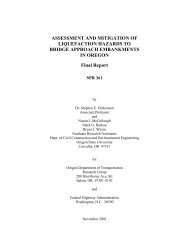Oregon Balance of State HIV/AIDS Housing & Services Systems ...
Oregon Balance of State HIV/AIDS Housing & Services Systems ...
Oregon Balance of State HIV/AIDS Housing & Services Systems ...
You also want an ePaper? Increase the reach of your titles
YUMPU automatically turns print PDFs into web optimized ePapers that Google loves.
<strong>Oregon</strong> <strong>HIV</strong>/<strong>AIDS</strong> <strong>Housing</strong> and <strong>Services</strong> <strong>Systems</strong> Integration Plan 5<br />
total population. 6 For comparison, neighboring Washington <strong>State</strong> (outside the Seattle EMA)<br />
included about 3.8 million people, or 60 percent <strong>of</strong> the state’s total population. 7<br />
Across the balance <strong>of</strong> the state <strong>of</strong> <strong>Oregon</strong>, population trends vary between areas <strong>of</strong> high growth and<br />
limited or negative population growth. Deschutes County, which grew the fastest between 1990 and<br />
2000, continues to lead <strong>Oregon</strong> counties in population growth. From 2000 to 2006, the population<br />
<strong>of</strong> Deschutes increased by 29 percent, fueled by the city <strong>of</strong> Bend, which grew by 35 percent.<br />
Neighboring Crook County grew by 20 percent. Other fast growing counties included Polk (17<br />
percent), Marion (9 percent), and Jackson Counties (9 percent).<br />
Ten counties in eastern <strong>Oregon</strong> have lost population since 2000, including Baker, Gilliam, Grant,<br />
Harney, Malheur, Sherman, Union, Wallowa, Wasco, and Wheeler Counties. These counties are<br />
largely rural and account for just three percent <strong>of</strong> <strong>Oregon</strong>’s total population.<br />
In 2006, the majority <strong>of</strong> the population (87 percent) <strong>of</strong> the state <strong>of</strong> <strong>Oregon</strong> was White. Asians were<br />
three percent <strong>of</strong> the population and two percent was Black/African American. In the balance <strong>of</strong><br />
state, 89 percent <strong>of</strong> the population was White, two percent was Asian, and less than one percent was<br />
Black/African American. Both statewide and in the balance <strong>of</strong> state, the 2006 population was 10<br />
percent Hispanic, regardless <strong>of</strong> race (meaning that a person could be counted as White as well as<br />
Hispanic, for example). 8<br />
6 U.S. Census. 2006 American Community Survey estimates. Available online: http://factfinder.census.gov/ (Accessed: November<br />
26, 2007).<br />
7 Washington <strong>State</strong> Office <strong>of</strong> Financial Management, Washington <strong>State</strong> Population Estimates. Available online:<br />
http://www.<strong>of</strong>m.wa.gov/pop/april1/default.asp (Accessed: January 10, 2008).<br />
8 U.S. Census. 2006 American Community Survey estimates. Available online: http://factfinder.census.gov/ (Accessed: November<br />
26, 2007).

















